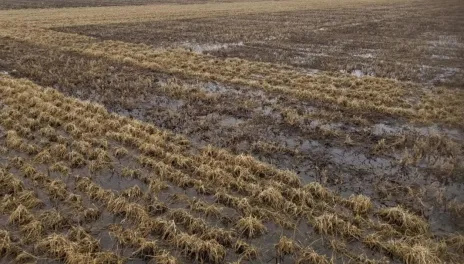Waiting for the soil to thaw
It is that time of year when we anxiously anticipate the start of planting season. For a while it looked like spring was just around the corner.
Regardless of what the air temperature is, the soil has to thaw first, then it needs to drain, then it has to warm up enough for seed to germinate. Each year we can only guess what day those conditions are likely to occur.
Here at the Carrington Research Extension Center we have a North Dakota Agricultural Weather Network (NDAWN) weather station on site, equipped with soil temperature sensors. The data from these sensors is updated every hour in the NDAWN website (NDAWN Deep Soil Temperatures (nodak.edu)) where it can be viewed and downloaded. The Carrington site has soil temperature readings dating back to the spring of 2014.
Whether for the purpose of trying to guess the first date of suitable planting conditions or just for the fun of it, there are several pieces of information that can be gleaned from that database. Let’s look at the deepest depth of soil frost each year, along with when that depth was first recorded, the last day that soil frost was recorded each spring and the dates top soil temperatures no longer dips below 35° F or 50° F. The table shows all these numbers for the last nine years.
Table 1. Soil frost and temperature related data extracted from the NDAWN website
| Year | Maximum frost depth in inches | First day of maximum frost depth | Last day of soil frost | First day top soils stays above 35 F | First day top soil stays above 50 F |
| 2015 | 39 | 25-Feb | 22-Apr | 24-Apr | 23-May |
| 2016 | 31 | 20-Feb | 24-Mar | 14-Apr | 18-May |
| 2017 | 24 | 11-Jan | 12-Apr | 12-Apr | 31-May |
| 2018 | 49 | 8-Mar | 9-May | 28-Apr | 21-May |
| 2019 | 69+ | 22-Mar | 12-May | 17-Apr | 28-May |
| 2020 | 31 | 24-Feb | 30-Apr | 26-Apr | 19-May |
| 2021 | 31 | 14-Feb | 1-Apr | 3-Apr | 15-May |
| 2022 | 31 | 24-Feb | 21-Apr | 29-Apr | 24-May |
| 2023 | 20 | 27-Feb | 24-Apr | 26-Apr | 20-May |
| 2024 | 24 | 23-Jan | |||
| median | 31 | 24-Feb | 22-Apr | 24-Apr | 21-May |
| lowest | 20 | 11-Jan | 24-Mar | 3-Apr | 15-May |
| highest | 69+ | 22-Mar | 12-May | 29-Apr | 31-May |
Here are the highlights from the Carrington NDAWN station (2014-2024) soil temperature data:
Last day of soil frost: This is the day after which no more soil frost is recorded anywhere within the soil profile until fall. The earliest date was March 24, 2016 and the latest was May 12, 2019, with the median date falling on April 22. For half of the years on file the last bit of frost was near the surface, whereas in the other half of the years it was at 2 feet or below.
Maximum depth of frost: The soil frost was deepest in 2019. The sensors at Carrington only go down to 69 inches, but the frost likely went deeper than that, since that year the water main broke in Carrington which is placed at 8 feet below the surface. The most shallow measure of maximum frost depth was at 20 inches in 2023. The median depth that frost reached over the past nine years was 31 inches.
First day top soil stayed above 35° F until fall: The earliest date was April 3 (in 2021) and the latest was April 29 (in 2022). The median date was April 24.
First day top soil stayed above 50° F until fall: The earliest date was the of May 15 (in 2021) and the latest was the 31st of May (in 2017). The median date was the 21st of May.
This spring: As of March 18, the soil at our site is frozen from the surface down to two feet. This is also the median depth of soil frost for March 18 for the last 9 years. The lowest on this date was no frost in the soil profile in three of the years, and the deepest frost on this date was at 49 inches starting from the surface in 2019.
Based on the current soil frost situation, and with the colder weather being forecasted, it looks like we don’t need to get too antsy to get out there to plant just yet.
Szilvia Yuja
Szilvia.ZilahiSebess@ndsu.edu
Soils Research Specialist
